The Oscar fish (Astronotus ocellatus) is one of the most recognizable cichlids, sporting a large personality along with iconic red and orange zebra-striped patterns.

They quickly win fans with their puppy-like behaviors of excitation at feeding time. However, that same ravenous hunger can spell doom for more docile tankmates like the vividly-hued Blue Acara cichlid (Aequidens pulcher).
Oscar Fish Eating Blue Acaras is a big problem among aquarists. With some adjustments though, aquarists can curtail the carnage.
The Predatory Nature of Oscars
Jump To
Oscars are a largemouth cichlid native to South America. Growing up to 12 inches long in home aquariums, they become one of the biggest predators in community tanks. Despite their charm, Oscars are hardwired for the hunt with:
- Large mouths filled with pointed teeth for seizing prey
- Powerful jaw muscles to deliver crushing bites
- Excellent vision to spot victims across distances
- Lightning-fast burst swimming speed to ambush
- Highly developed sense of smell to track fish
- Intelligent brains to plan attacks and lay traps
This combination of traits makes them deadly hunters. Aquarists must never underestimate an Oscar’s ability to capture and consume tankmates. They are eating machines, plain and simple.

The Vulnerability of Blue Acaras
In contrast, the beautiful Blue Acara hails from the same South American waters but as a passive, slow-moving species. Blue Acaras spend their time drifting gently among plants and rooting in substrate. Their vulnerabilities include:
- Smaller average adult size of 5 inches
- Delicate flowing fins that hamper swimming
- Relatively small mouths limiting bite force
- Peaceful temperament making them freeze, not flee
- Tendency to hide rather than fight back when threatened
- Bright blue hues that stand out against aquatic plants
These traits signal easy prey to an Oscar on the prowl. And unlike some cichlids, Blue Acaras do not naturally school together or show coordinated defenses. Once singled out, they seldom escape an Oscar’s clutches.
Oscar and Acara Interactions in Aquariums
Despite coming from the same ecosystem originally, Oscars and Blue Acaras have limited cohabitation success long-term in home tanks. As juveniles, Oscars largely ignore shrimp-sized tankmates. But once an Oscar reaches 4-6 inches itself, its shark-like predatory nature kicks in.
At that point, any small fish become targets, and sedate Blue Acaras make perfect victims. Oscars may initially intimidate them, then progress to nipping off fins and taking bites from the flank or tail. Few Blue Acaras survive these assaults.
Adding other dither fish may temporarily distract an Oscar, but usually only delays the inevitable Acara feast. Once an Oscar gets a taste, it singles out Blue Acaras over less appetizing fare.
Preventing Loss of Blue Acaras to Oscars
Completely curbing Oscar predation is difficult but not impossible. Using these key strategies bolsters Blue Acaras’ odds of coexisting safely:
- Keep the Oscar well-fed on protein-rich foods like shrimp, massivore pellets, and earthworms. A full Oscar has less drive to hunt tankmates.
- Rear the Oscar with Blue Acaras from a young age. Familiarity makes the Acaras less likely to become prey later on.
- Provide lots of sight barriers such as rockwork, driftwood, and thick plants in terraces. This allows the Acaras to stay out of sight.
- Use a very large tank, over 125 gallons. Ample room grants areas for each species to establish natural territories.
- Arrange decor to create escape routes and hiding spots for the Acaras during Oscar attacks.
- Add tankmates that can peacefully hold their own against the Oscar, like large catfish. These divert nipping behaviors.
- Install a tank partition right away at any signs of focused Oscar harassment of Acaras. Separate before losses occur.
Remaining vigilant for signs of aggression, acting preemptively, and optimizing the tank setup are key to preserving Blue Acara numbers.
Curbing Oscar Aggression in Community Tanks
Aside from housing changes, owners can take direct steps to discourage Oscar predation on tankmates:
- Increase water changes to reduce territoriality linked to accumulated waste hormones.
- Rear the Oscar alone for the first 6 months. Adding tankmates later decreases ingrained predatory behaviors.
- Feed the Oscar shortly before introducing new fish. A full stomach makes them less likely to hunt new arrivals.
- Arrange tank decor in a purposefully chaotic, asymmetric way. This lowers Oscar territoriality.
- Use diffused, low lighting to minimize the Oscar’s vision advantage. Keep live plants to lower visibility.
- Add hiding spaces designed for small fish to retreat into when the Oscar approaches.
- Monitor the Oscar’s behavior and separate immediately if fixating on the Acaras.
Preconditioning the Oscar to coexist with other fish, reducing aggression triggers, and optimizing conditions gives peace a fighting chance.

When to Separate Oscar and Blue Acara Tankmates
Unfortunately, the hunter’s urge may simply prove too powerful for some individual Oscars to resist. After exhausting the above methods, accepting defeat may be the only way to preserve vulnerable Blue Acaras.
Signs it’s time to separate include:
- The Oscar continually harasses, chases, or nips at the Acaras despite preventive measures.
- Evidence of bite marks or injuries on the Acaras, even if Oscar aggression is intermittent.
- Acaras hiding the majority of the time due to perpetual threat.
- The Oscar lingering near Acara shelter spots awaiting chances to ambush.
- Disappearances of healthy Acaras when the Oscar is confirmed present.
While disappointing to surrender the dream of a blended cichlid community, splitting up the tank is better than losing prized Blue Acaras. Both species can thrive separately with care tailored to their differences.
Providing the Best Life for Each Species
Caring for Oscar and Blue Acara cichlids in separate dedicated tanks plays to each fish’s strengths once aggressive predation becomes evident.
For Oscars, focus on:
- Large tank with minimum 75 gallons for a single Oscar, adding 10+ gallons per extra Oscar
- Powerful filtration and frequent water changes to control the heavy waste of carnivore diets
- Open swimming space since Oscars rarely use plants or decorations
- Daily protein-focused feeds such as shrimp, Krill, massivore pellets, and frozen foods
- Tankmates able to defend themselves from Oscar aggression like large plecos
For Blue Acaras, create an environment with:
- Planted aquascape with lots of rocks, driftwood, and hiding spots
- Standard community tank filtration with weekly 25% water changes
- Varied diet including flakes, pellets, freeze-dried, frozen, and live foods
- Peaceful tankmates like small tetras, Cory cats, pencilfish, and apistos
- Subdued lighting and a tranquil setting away from high-traffic areas
Sometimes, stocking dreams simply don’t work out. But by playing to their natural strengths in separate optimized habitats, both Oscars and Blue Acaras can thrive in aquariums. The health and happiness of these amazing fish is the ultimate goal.
Read Next:
How To Stop Oscar Aggression ? (12 Important Tips)
The Complete Oscar Fish Care Guide|Oscars A Long & Healthy Life
